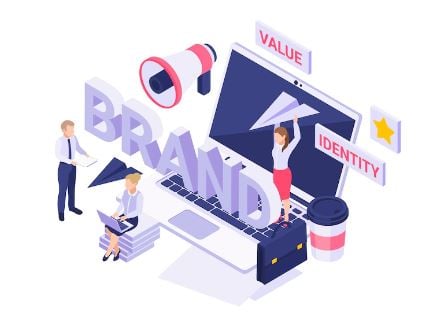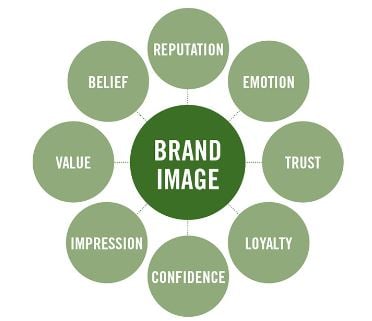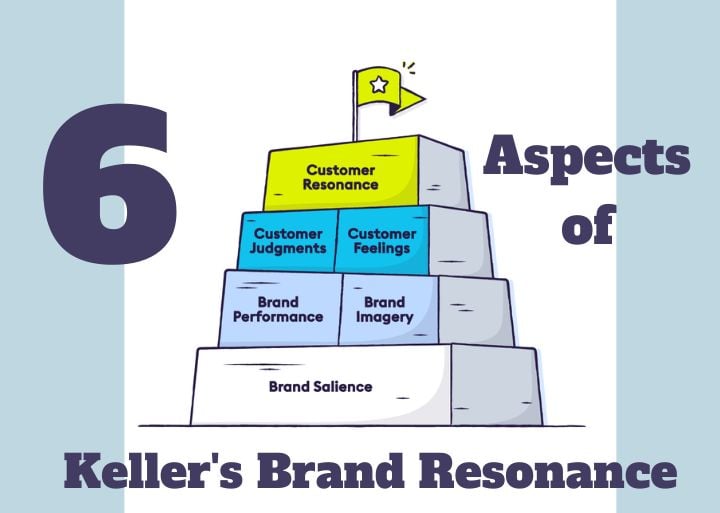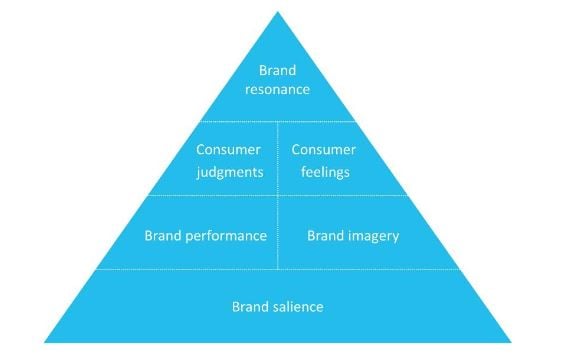It is natural to conclude that a company should cultivate close-knit relationships with their customers to create an amazing experience so they would want to return. 93% of consumers would make repeat purchases from a brand if they had a positive experience. Not only that, but 68% are willing to pay extra for products if a brand is known to offer a better experience.
However, building up brand loyalty is not as easy and quick as we’d want it to be. Loyalty is the most common result of brand resonance, which is what you need to start improving.
Brand resonance refers to how well a customer relates to a good, and it is separated into 6 aspects: Salience, Performance, Imagery, Judgment, Feelings, and, finally, Resonance itself.
Let’s look at each of these aspects, and how this model by Kevin Lane Keller, a Professor of Marketing in Dartmouth College, can help you to achieve brand resonance. And, ultimately, the love and loyalty of your customers.
1) Brand Salience

Brand salience belongs to the first rung in the pyramid, and it is essentially the question: “Who are you?”
This is where you have to introduce yourself to customers, let them know what you are selling, and what you stand for. This rung forms the foundation of brand resonance—if people don’t know who you are, they aren’t going to buy from you, period.
Transparency is important here—you cannot skip out on crystal-clear communication, as 32% of consumers would start using a brand if it offers full product transparency. You want your customers to know how you can fulfil their needs, as well as your goals and values. Research your target market and their pain points, and how your product or service is tailored to help them solve their problems.
This will take some time, and that’s perfectly normal. After all, it takes 5-7 impressions for people to remember your brand. Promote your brand across as many channels as you can manage, and maybe even adopting an omnichannel strategy. However, you need to ensure that your branding efforts is consistent across all channels—according to Forbes, it can increase your revenue by up to 23%.
Vouchermatic can help you with that through our gamified platforms. With Lucky Draws or Spin-the-Wheel campaigns, you can be sure to attract a great number of customers who would be interested in the thrills and excitement you offer.
Additionally, with Vouchermatic, we can help you to implement campaigns to spread awareness about your brand, such as by creating deals with your chosen influencers, making it easy and convenient for them to distribute your coupons or vouchers to their followers.
2) Brand Performance
This is rather straightforward—brand performance refers to how well your brand can serve the needs of your customers.
By Keller’s model, brand performance is split into 7 categories, including:
- Product reliability: Is the product defective?
- Product durability: How long does it take for the product to wear out?
- Product functionality: How well does the features of your product suit your customer’s needs?
- Style/Design: How does the product look? Is it aesthetically pleasing?
- Customer service: Was interacting with the brand a positive experience for the customer?
- Customer satisfaction: How satisfied is the customer overall?
- Price: How much does the customer have to pay for the product?
Based on these categories, the customer will determine whether or not the product suits their needs, and how different your product is from your rivals’. To stand out, brand differentiation is a must; how different are your products from your competitors’ who are offering similar goods or services?
3) Brand Image

Brand imagery refers to how customers view your brand. This tends to be in the form of your image: what do customers associate your brand with, and this usually comes with emotions that would be invoked in relation to it.
This also takes into account your brand’s persona, and the kind of message you would like to relay to your customers. Getting your brand image right from the get-go is key in attracting customers who resonate with your views. According to LoyaltyLion, 90% of consumers would switch to brands that share their values and outlooks on life.
4) Brand Judgement
Once customers get an idea of what your brand is about and how you can serve their wants or needs, they are going to pit you against other brands that offer similar products. According to Keller’s model, they will judge you based on four categories:
- Quality: Customers will judge your products based on its actual and perceived quality. You need to put some focus on getting your products’ quality on par with your competitors’.
- Credibility: Customers are more likely to trust a company that appears to be an expert on what they are selling. Back up your key messages with research, and don’t be afraid to promote that.
- Consideration: Customers are quick to brush aside your products if it’s not relevant to their needs. Circumventing this is easy as long as you’ve done your research, and you have a good idea of what your target audience desires.
- Superiority: You need to rise over all others in your industry to gain your customers’ support. On the same vein as brand differentiation, is there anything that you can offer your customers that other brands do not?
Ensuring that you are a cut above the rest may make or break your business; it has been found that 50% of customers have left a brand for competitors that were better aligned with their needs.
Don’t forget that customers need not have bought from you to form an opinion. Hearing about you from others is just as powerful in eliciting judgement from customers that probably have never encountered your before.
To mitigate negative judgements, it is necessary to have good customer service recovery. You need to be proactive in listening to customers’ complaints and addressing their concerns. If negative reviews still persist, then you may need to take a step back and reassess your brand.
Negative reviews are devastating, but it’s not the end of the world. Vouchermatic offers you a way to, hopefully, retain your unhappy customer by offering them a voucher or coupon to thank them for sharing their feedback, and as part of a promise to respond accordingly to their concerns.
5) Brand Feelings

Brand feelings may sound superficial, but they are absolutely required if you want to form a positive reputation. It is expressed by the amount of attachment customers have towards a brand, which can be enhanced via exceptional customer experience.
Customer experience is crucial to nearly every part of a customer’s journey, from new customer acquisition to retention.
According to a study by Walker, customer experience would overtake product and price as the key brand differentiator by the end of 2020. PwC states that 33% of customers would leave a brand they loved after just one bad experience, and 92% would just abandon a brand after 2 to 3 negative interactions.
Esteban Kolsky also found that if customer experience is good, then 72% of them would share it with 6 or more people. On the other hand, if a customer has a terrible experience, then 13% of them would share it with 15 or more people.
The worst part of this is that they won’t tell you—only 1 in 26 unhappy customers actually complain. This could spell the end of your company long before you realise that something is wrong.
To reduce the loss of your revenue, it is vital that you invoke positive brand feelings from the very start, before you let negative emotions take root.
By Keller’s model, there are 6 potential positive brand feelings that you should aim for: warmth, fun, excitement, security, social approval, and self-respect.
That is not to say that your company must evoke all six—that is next to impossible. However, you should at least be able to trigger one—when customers think of your brand, they should be feeling that exact emotion.
How to do this? Simple: personalise your customer’s experience. It all boils down to the level of emotional connection between your customer and your brand.
Done right, personalisation would cultivate precious trust which will grow strong and long-lasting relationships between your brand and your customer. As it turns out, 66% of customers are open to switching brands if a competitor offers a better experience.
Customer experience is a big part of who we are at Vouchermatic, and we are committed to ensuring that your customers have the best experience they can when interacting with your brand. We offer a variety of services including the aforementioned gamification platform and a voucher management system that can help you acquire your customers’ data so that you can tailor their exposure to your products that they are interested in.
Moreover, you can send them promotions and deals that suit their taste, keeping them interested and building up that sweet, sweet customer bond.
6) Brand Resonance
Finally, the last piece of the puzzle, the tip of the pyramid, is brand resonance. When you achieve brand resonance with a customer, you have solidified relationship between your brand and your customer.
There are four tiers to brand resonance:
- Behavioural loyalty: When customers need the type of products you sell, they will think of you first, and they will patronise your store before others.
- Attitudinal attachment: There is something to be said about customers treating your brand or product as a special treat for themselves.
- Sense of community: Your customer finds solidarity with other people who purchase your products, or even with your company representatives.
- Active engagement: The highest tier of brand resonance, your customers actively engage with your brand, such as participating in forums or clubs relating to your brand.
Ideally, you’d want to get as many customers as possible to actively engage with your brand, and it is possible to do this through simple initiatives like loyalty programs and special discounts.
Even creating sites that promote discussions between your customers can help to foster a community surrounding your brand, and encourage people to share their thoughts.
According to Microsoft, a 7% increase in brand loyalty leads to an 85% increase in the customer lifetime value of each client. To add on to that, a 5% increase in customer retention can lead to a 25% increase in profit—43% of customers that are loyal to a brand will spend more on their products or services.
If you’re looking to implement a loyalty program or to improve on your existing one, then Vouchermatic is here for you. We have several gamification elements that we can incorporate seamlessly into your current web page or app, such as Stamp and Scratch Cards to entice your customers to sign up, participate, and redeem rewards.
Conclusion
Now that we are familiar with the 6 aspects of brand resonance, it is time to translate that theory lesson into practical applications.
The most important point gleaned from all that we have discussed is that customer experience should rank number one on your priority list, as that is what customers tend to judge companies on.
Vouchermatic is dedicated to keeping your customers happy with our voucher management system, gamification, and other even helping you acquire customer data for better customer experiences. Building up brand resonance is not easy and is a painstakingly slow process, but it will never happen if you don’t take the first step.
Start building up your brand resonance with us now!


